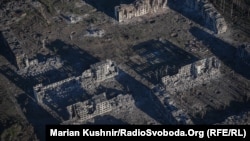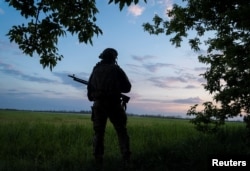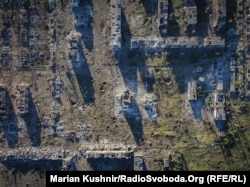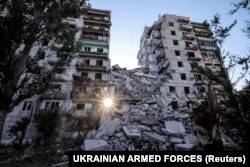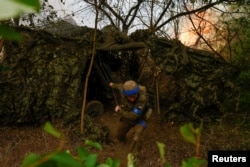It’s the dog days of a brutal summer on Ukraine’s battlefields, where Russian advances have been slow but relentless and Ukrainian forces are stretched thin by a lack of soldiers, strained by the exhausted frontline units unable to rotate out for rest.
After several months of uncertainty -- when Western weapons supplies slowed to a trickle and Ukraine struggled to replenish its troop numbers -- the situation has more or less stabilized for Kyiv.
“Things are better [than in the spring], despite the huge number of clashes,” said Serhiy Hrabskiy, a retired Ukrainian Army colonel.
But at 28 months and counting since Russia’s all-out invasion, there’s no end in sight to Europe’s largest land war since World War II.
The human toll continues to mount. Total casualties -- dead and wounded -- now exceed 500,000, according to Western estimates, but are likely far higher. Britain’s top military officer said Russia alone had suffered that many casualties as of last month, and Russian news organizations, using probate data, have estimated as many as 140,000 Russian soldiers have died since February 2022. Ukraine has not disclosed its casualty figures, although President Volodymyr Zelenskiy said in February that 31,000 soldiers had been killed in the previous two years -- a figure seen as a gross undercount.
“Ukraine is in a difficult position now, manpower-wise, and they are going to struggle until mobilization starts delivering significant new manpower to the front,” said Konrad Muzyka, a Polish military analyst who recently returned from a trip to some of the frontline positions. “The biggest question is when these mobilized guys start entering the front line.”
Here’s a look at where things stand on the battlefield, along the nearly 1,200-kilometer front line that stretches from the mouth of the Dnieper River in Ukraine’s south up to the Russian border north of Kharkiv in the east.
No, The Kharkiv Offensive Has Not Failed (But It’s Definitely Not Over, Either)
In early May, Russia opened a localized offensive along parts of the border near Kharkiv, Ukraine’s second-largest city. Thousands of troops, mainly infantry, with some armored units, crossed into Ukraine, with the main thrust pushing into Vovchansk, a town of 17,000 people before the invasion, located less than 10 kilometers from the border.
Ukraine quickly redeployed more experienced units from elsewhere, and Russian advances into Vovchansk morphed into slow, incremental street fighting, which continues today. The village was roughly 50 percent occupied by Russia as of July 12, and Russia is unlikely to advance farther.
It’s also unclear how Russian units would have fared if they had succeeded in moving south out of Vovchansk, where Ukrainian defenses are more formidable.
“Ukrainian forces stabilized the line of contact, then pushed back Russian forces,” Hrabskiy said. “I assume now that Russian forces will try to desperately keep their positions.”
Some Russian officials -- President Vladimir Putin among them -- said that the effort was aimed at creating a buffer zone -- to stop Ukrainian forces from launching cross-border attacks on cities like Belgorod. Or the goal may have been to put Kharkiv within artillery range, to threaten the city’s civilian population.
However, experts said the grouping and the number of forces utilized meant that Russian commanders had a different goal.
“The Kharkiv offensive wasn’t the offensive. It was just supposed to spread Ukrainian forces thin and force [the] Ukrainians to deploy reserves, to weaken lines somewhere else in the Donetsk Oblast,” Muzyka said. “To a limited extent, it worked.”
A U.S. decision allowing Ukraine to use U.S. weaponry to hit Russian targets across the border from the Kharkiv region also helped the effort, forcing Russia to relocate some of its missile batteries and forward-operating aircraft.
The Coming Fall Of Chasiv Yar?
Located on a height of land about 15 kilometers west of the obliterated city of Bakhmut, Chasiv Yar had been the goal of Russian forces for at least a month before the Kharkiv offensive.
The town’s heights make it ideal for targeting artillery and reconnaissance, and capturing it would allow Russian troops to threaten a key railway junction at Kostyantynivka, used by Ukraine to supply frontline units.
Ukrainian defenses have relied in part on the Siverskiy Donets-Donbas Canal, a waterway running north to south and separating the town’s main center from an outlying eastern district known as Kanal. Ukrainian forces withdrew from Kanal on July 4.
"It became impractical to hold the Kanal neighborhood after the enemy entered it because it threatened the lives and health of our servicemen, and the positions of our defenders were destroyed," Nazar Voloshyn, a spokesman for the Khortytsia grouping of forces, said in televised comments.
In Chasiv Yar, as in other places along the front line, Ukrainian positions have also been ravaged by Russian glide bombs -- high-explosive bombs that are retrofitted with smart guidance systems then delivered to targets by fighter jets.
Ukraine has no great way to defend against them. The bombs are near impossible to intercept and Ukrainian air-defense systems are at a premium, particularly ones like the U.S.-built Patriot systems, which would be targeted themselves if they were deployed close to the front line.
“They can destroy the entire tree line with a few [glide bombs] and make it indefensible,” Muzyka said.
How long can Ukraine hold out in Chasiv Yar? The Center for Defense Strategies, a Kyiv-based think tank headed by a former defense minister, predicted it could fall to the Russians before the end of the summer, though that would come with substantial losses.
Frontelligence Insight, an open-source organization run by a Ukrainian reserve officer, also predicted the town would eventually fall to the Russians.
Toretsk Torrents
About 25 kilometers south of Chasiv Yar, the former mining city of Toretsk had suffered relatively little compared with other Donetsk settlements close to the front lines. Last month, however, Russian forces began making tangible advances toward the city, claiming the village of Shumy, about 10 kilometers to the east.
Ukraine’s top military officer, Colonel General Oleksandr Syrskiy, said on July 2 that fighting had intensified around Toretsk.
Russian units also punched through Ukrainian lines south of Toretsk, creating a bulge, or salient, near Nyu-York, a village widely known as New York.
It’s unclear exactly why Russian forces were able to move forward so quickly, though open-source intelligence reports point to a Ukrainian troop rotation that may have been botched.
“The Russians very effectively use the lack of communications between troops, problems of coordination between units,” he said. "I’m disappointed about it…but this is war. You’re a soldier in war. You use whatever advantage you can get. The Russians took advantage.”
Aerial video released on July 11 by the 32nd Separate Mechanized Brigade -- one of Ukraine’s more battle-hardened units -- showed the city largely reduced to rubble.
Toretsk is likely the primary objective for Russian commanders right now, Hrabskiy said, because capturing it would give Russia control over a wider urban area stretching along the western edges of the Donetsk region.
“For the Russians, it is critically important for them to capture this location," he said. “Attacking Toretsk head-on; they’re in a hurry. The window of opportunity is starting to close, because the current flow of men and weapons is turning to Ukrainian advantage.”
To the southwest of Toretsk, Russian forces have also pushed north and northwest out of the town of Ocheretyne, creeping toward the N32 highway, which runs from Pokrovsk to the northeast to Kostyantynivka. Capturing the highway would cut off a major supply line for Ukrainian forces in the area.
Of Men and Planes
In addition to exhausted troops and problems with unit coordination, analysts also have reported seeing problems with poorly trained soldiers and soldiers whose age -- over 40 -- makes them less effective.
In his July 2 statement, Syrskiy himself alluded to the personnel problems: for Ukrainian commanders, the biggest issue is "manning units with motivated, well-trained military troops.”
Still, Ukraine’s system for mobilizing, training, and deploying more men is gradually gearing up. That, plus the renewed flow of U.S. and Western weaponry, should give Ukraine the ability to definitively stabilize its lines, possibly within the next six to eight weeks.
“Mobilization is delivering good numbers,” Muzyka said. “To what extent they can sustain that is unclear.”
For that reason, Russia is pushing hard toward Toretsk and Chasiv Yar, and digging in outside of Vovchansk, trying to secure tangible successes soon.
"We've probably passed, or about to pass, the greatest period of vulnerability. Things were looking pretty bad [for Ukraine] in April; I would say pretty grim,” Michael Kofman, a defense analyst at the Carnegie Endowment for International Peace, said in a podcast last month.
“If you look at shipments of ammunition; if you look at the front steadily stabilizing, at least in most places, even though the Ukrainian forces are stretched in some; if you look at Ukraine's recent efforts to significantly increase mobilization, then we're likely passing out this period [of vulnerability] once we get to July, August, thereabouts,” said Kofman, who also just returned from Ukraine.
But even with a new influx of soldiers, Ukraine’s wider disadvantages are clear: Russia has a far larger population to draw from to replenish its losses -- and has used extraordinarily lucrative wage offers and survivor and death benefits to attract volunteer soldiers.
For Russia, “there’s steady flow of men to do head-on infantry assaults. That allows Russia to maintain pressure on Ukrainians across the wider front,” Muzyka said.
Still, evidence that Russia is having to stretch its own units and capabilities are showing up on the battlefield.
Hrabskiy said Russian units were increasingly using vehicles to transport infantry that are not intended for that purpose: things like MT-LBs, which are lightly armored amphibious vehicles usually used for towing artillery or other equipment. Russian troops have also been seen using motorcycles and ATVs to conduct small-scale assaults.
'More Attacks Will Be Coming'
Ukraine's biggest worry would be its electricity grid, which has been pummeled by Russian missiles and drones for months now. Even as Ukrainian air defenses have improved, Ukrainian engineers have struggled to replace generating capacity, and repair damaged lines, transformers, substations, and other power infrastructure.
“I’m very certain they are not going to get necessary additional power connected” before the winter, Muzyka said. “More attacks will be coming, maybe in the autumn, because the grid is very, very vulnerable now, on the brink of collapse.
“In general, the Ukrainians are expecting that major cities will have massive blackouts this winter; maybe three hours of electricity during the day, three hours at night,” he said.
